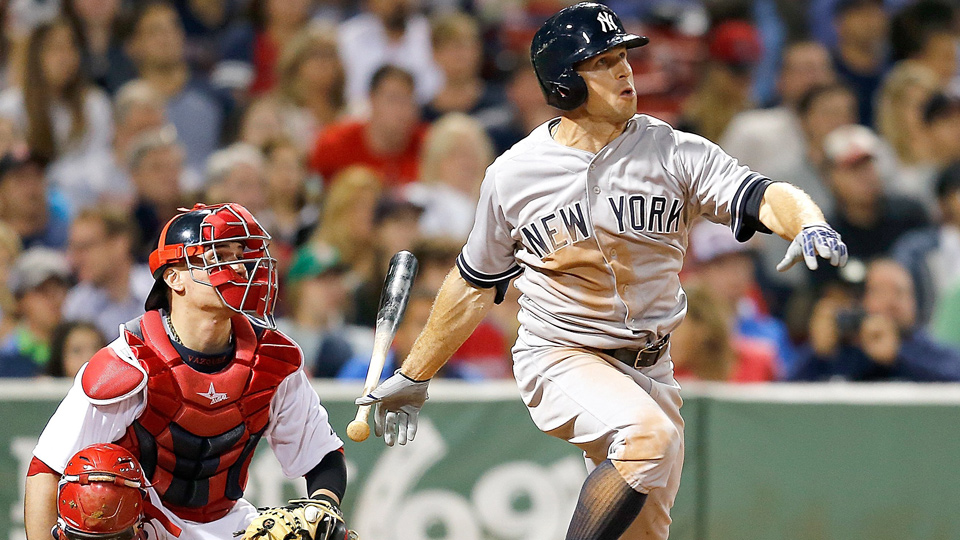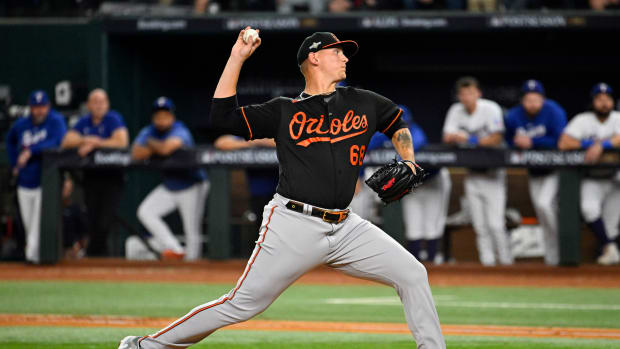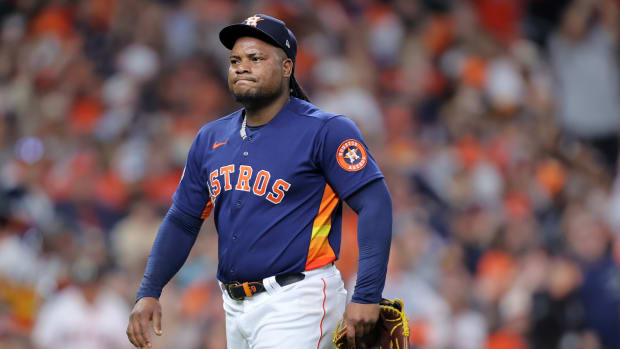Brett Gardner proving unlikely MVP in career year for Yankees
After losing five out of six games to the Blue Jays, Rangers and Red Sox, the Yankees salvaged their weekend series in Fenway Park by taking the final two games of a three-game series. They won a seesaw epic on Sunday night behind the big bat of Brett Gardner, who stroked a game-tying two-run double off Clay Buchholz in the third inning, then bashed a decisive home run off Craig Breslow in the sixth; elsewhere in the game, he added a single and a walk.
Via MLB.com, here's the video of the home run, which came when Breslow offered an 87 mph fastball in the strike zone on a 2-0 count. That blast turned a tie ballgame into an 8-7 advantage that New York preserved over the final three and a half frames:
The 30-year-old Gardner has been on quite the tear lately, hitting five homers in the last week. Four of those came in three games in Texas, two of them off of Yu Darvish — whom he'd previously touched up on July 23 in the Bronx — in the series opener and then game-openers against Nick Martinez and Colby Lewis as the series progressed. Gardner has now got 15 dingers on the year, which is not only a career high but also matches his previous two best seasons — eight last year, seven in 2011 — combined. He hit seven in July alone, after hitting four in June; prior to this season, he'd never homered more than three times in a single month, and he had hit just 23 through 2,228 career plate appearances, one for every 96.8 PA.
Only Mark Teixeira, with 19, has more home runs for the Yankees than Gardner, whose 131 OPS+, on a .284/.363/.467 line, is a team high. As you might guess, both the OPS+ and slugging percentage blow away his previous career bests of 110 and .416, set last year. The extra power, when combined with his outstanding patience (his 4.47 pitches per PA is second only to Mike Trout among AL hitters), excellent baserunning (18 steals in 22 attempts, +4 runs) and typically strong defense (+6 Defensive Runs Saved) have helped him to a team-best 4.3 WAR, which represents outstanding value for the $5.6 million that the Yankees are paying him this year. He inked a four-year, $52 million extension in February that begins next season and which looks like a particularly shrewd move by general manager Brian Cashman given that the team that hasn't gotten much from most of its highest-paid players.
What's behind Gardner's power outburst? Much of it is owed to his home park; he's batting .306/.373/.495 at Yankee Stadium, up from .277/.341/.421 last year and .266/.360/.392 from 2009 (when the new park opened) through 2013. Coming into this season, 16 of his 23 career homers had come in that Bronx bandbox, but in 2014, eight of his 15 homers have come on the road. Away from New York, he's batting .264/.354/.443, compared to .269/.347/.410 in 2013 and .274/.353/.383 in the comparable 2009-13 period. Relative to 2013, he's gained 74 points of slugging percentage at home and 33 points on the road; taking 2009-13 combined, the gaps are 103 and 60 points, respectively.
Looking at his PITCHf/x data at BrooksBaseball.net, Gardner continues to hit the vast majority of his homers on two- and four-seam fastballs. Via his Zone Profile, he's doing most of his damage on pitches lower down in the strike zone. Comparing his slugging percentage in the zone on contact this year with everything prior:
As you can see in the graph on the left, Gardner's slugging percentages entering this season were fairly consistent from top to bottom — .437 in the upper third, .453 in the middle third and .457 in the lower third — but there's a whole lot more separation within the smaller sample size of this year's data (the graph on the right). He's slugging .405 in the upper third, .591 in the middle third and .622 in the bottom third. Within both sets, he's been roughly as productive on the inner third as the outer third (.426 and .412, respectively, through 2013, .506 and .537 in 2014) but of course more productive in the middle third (.499 and .653).
One new tool that helps give a better feel for his results is Bill Petti's interactive spray tool chart at FanGraphs, which uses PITCHf/x data that goes back to 2010. According to that, from 2010-13, Gardner's average flyball distance was 251.1 feet, whereas this year, it's 277.1 — a big enough difference that we shouldn't be surprised at his spike in homers. The gap is even bigger when confining the average to the bottom third of the zone, increasing from 269.2 feet for 2010-13 to 300.3 feet this year.
However he's doing it, Gardner has been a much-needed source of power for an underwhelming offense. The Yankees are scoring just 4.05 runs per game, ninth in the league and 0.21 below the AL average; their .386 slugging percentage, also ninth, is 10 points below average. That said, they’ve been slightly more Bronx Bomber-like since the All-Star break, scoring 4.44 runs per game and slugging .418, with a healthier Carlos Beltran (.383/.433/.633 in 67 PA) providing a welcome jolt alongside Gardner (.315 /.414/.741 in 71 PA).
Trade deadline roundup: Nationals upgrade infield, Red Sox stay busy
Despite their injury-wracked (if recently patched) rotation and similarly subpar run prevention (4.31 runs per game, ninth in the league and 0.09 worse than average), New York is 10-6 since the break and 57-53 overall, five games out of first place in the AL East and 1 1/2 back in the wild card. The Baseball Prospectus Playoff Odds report gives the team a 21.3 percent chance of making the playoffs, split evenly between the two routes. While the best the Yankees can do is keep their fingers crossed as starters MasahiroTanaka and Michael Pineda rehab from injuries, the recently acquired Brandon McCarthy has at least helped stabilize the rotation, and pre-deadline lineup additions Chase Headley and Stephen Drew figure to provide more punch than the since-departed Brian Roberts, Kelly Johnson and YangervisSolarte. But for even having a shot at continued relevance, they owe a big thanks to Gardner.




































